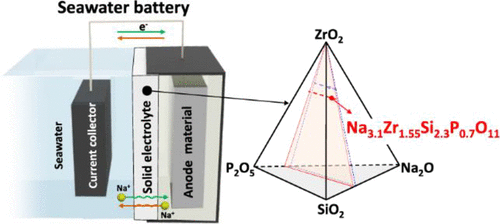Investigation on the Structure and Properties of Na3.1Zr1.55Si2.3P0.7O11 as a Solid Electrolyte and Its Application in a Seawater Battery
- Journal
- ACS Appl. Mater.
- Vol
- 13
- Page
- 52727-52735
- Year
- 2021
- Link
- https://pubs.acs.org/doi/full/10.1021/acsami.1c17338 934회 연결
The ionic conductivity, bend strength, and electrochemical performance in a seawater battery (SWB) of an Na3.1Zr1.55Si2.3P0.7O11 (vA-NASICON) solid electrolyte were compared to those of Na3Zr2Si2PO12 (H-NASICON). vA-NASICON exhibited three times higher total ionic conductivity (8.6 × 10–4 S/cm) than H-NASICON (2.9 × 10–4 S/cm). This is due to the higher bulk ionic conductivity and lower grain boundary resistance of vA-NASICON. The higher bulk conductivity of vA-NASICON is a result of its higher Na content, leading to a larger concentration of charge carriers and/or the formation of a higher conductive rhombohedral phase. The lower grain boundary resistance of vA-NASICON is a result of its larger grain size and reduced ZrO2 content. The bend strength of vA-NASICON (95 MPa) was 30% higher than that of the H-NASICON ceramic. The higher bend strength of vA-NASICON was attributed to its reduced ZrO2 secondary phase (1.1 vol %) compared to that of H-NASICON (2.6 vol %). When the vA-NASICON ceramic was tested in the SWB as a solid electrolyte, an 8.27% improved voltage efficiency and 81% higher power output were demonstrated, compared to those of H-NASICON, as a result of its higher total ionic conductivity and mechanical strength. At the same time, the vA-NASICON membrane revealed comparable cycle life (1000 h) to that of H-NASICON. These results suggest that vA-NASICON can be a better alternative than H-NASICON for use in the SWB.

